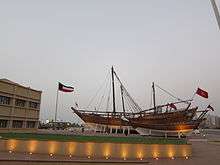Sheikhdom of Kuwait
The Sheikhdom of Kuwait (مشيخة الكويت Mshīkha al-Kuwayt) was a sheikhdom which gained independence from the Khalidi Emirate of Al Hasa under Sabah I bin Jaber in the year 1752. The Sheikhdom became a British protectorate between 1899 and 1961 after the Anglo-Kuwaiti agreement of 1899 was signed between Sheikh Mubarak Al-Sabah and the British government in India due to severe threats to Kuwait's independence from the Ottoman Empire.
Sheikhdom of Kuwait مشيخة الكويت Mshīkha al-Kuwayt | |||||||||
|---|---|---|---|---|---|---|---|---|---|
| 1752–1961 | |||||||||
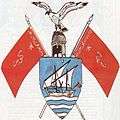 Coat of Arms
| |||||||||
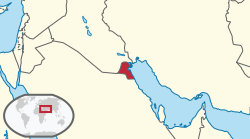 | |||||||||
| Status | Independent state, Protectorate of the British Empire from 1899–1961 | ||||||||
| Capital | Kuwait City | ||||||||
| Common languages | Kuwaiti Arabic | ||||||||
| Religion | Islam | ||||||||
| Government | Sheikhdom | ||||||||
| Historical era | 18th-20th centuries | ||||||||
• Established | 1752 | ||||||||
• Disestablished | 1961 | ||||||||
| Area | |||||||||
| 1920 | 17,820 km2 (6,880 sq mi) | ||||||||
| 1961 | 17,820 km2 (6,880 sq mi) | ||||||||
| Population | |||||||||
• 1920 | 50,000 | ||||||||
• 1961 | 321,600 | ||||||||
| Currency | Kuwaiti dinar | ||||||||
| ISO 3166 code | KW | ||||||||
| |||||||||
| Today part of | |||||||||
Foundation
Founding
Kuwait was founded in 1613 AD as a fishing village known as Grane (Kureyn). The region soon came under the rule of the Bani Khalid in 1670 after the expulsion of the Ottomans from Eastern Arabia (Lahsa Eyalet) by Barrack bin Ghurayr, Emir of the Bani Khalid, who successfully besieged the Ottoman governor Umar Pasha who surrendered and gave up his rule as the fourth Ottoman governor of al-Hasa.[1][2][3]
The families of the Bani Utbah finally arrived in Kuwait in 1713 AD and settled after receiving permission from the Emir of al-Hasa Sa'dun bin Muhammad who ruled from 1691–1722 AD. The Utubs didn't immediately settle in Kuwait however, they roamed for half a century before finally settling. They first left the region of Najd in central Arabia and settled themselves in what is now Qatar, after a quarrel between them and some of the inhabitants of the region they departed and settled near Umm Qasr living as brigands, raiding passing caravans and levying taxes over the shipping of the Shatt al-Arab.[4] Due to these practices, they were driven out of the area by the Ottoman Mutasallim of Basra and later lived in Sabiyya an area bordering the north of Kuwait Bay, until finally requesting permission from the Bani Khalid to settle in Kuwait which was then under the rule of the Emir of al-Hasa who himself was of the Bani Khalid.[5]
In 1718, the head of each family in the town of Kuwait gathered and chose Sabah I bin Jaber as the Sheikh of Kuwait becoming a governor of sorts underneath the Emir of Al Hasa. During this time as well, the power in governance was split between the Al Sabah, Al Khalifa, and Al Jalahma families in which the Al Sabah will have control over the reins of power whereas the Al Khalifa were in charge of trade and the flow of money, and the Jalahma would be in charge over work in the sea.
In 1752, Kuwait became independent after an agreement between the Sheikh of Kuwait and the Emir of Al Hasa in which Al Hasa recognised Sabah I bin Jaber's independent rule over Kuwait and in exchange Kuwait would not ally itself or support the enemies of Al Hasa or interfere in the internal affairs of Al Hasa in any way.
Economic prosperity
In the eighteenth century, Kuwait prospered and rapidly became the principal commercial centre for the transit of goods between India, Muscat, Baghdad and Arabia.[6][7] By the mid 1700s, Kuwait had already established itself as the major trading route from the Persian Gulf to Aleppo.[8]
During the Persian siege of Basra in 1775—1779, Iraqi merchants took refuge in Kuwait and were partly instrumental in the expansion of Kuwait's boat-building and trading activities.[9] As a result, Kuwait's maritime commerce boomed.[9] Between the years 1775 and 1779, the Indian trade routes with Baghdad, Aleppo, Smyrna and Constantinople were diverted to Kuwait.[8] The English Factory was diverted to Kuwait in 1792, which consequently expanded Kuwait's resources beyond fishing and pearling.[8] The English Factory secured the sea routes between Kuwait, India and the east coasts of Africa.[8] This allowed Kuwaiti vessels to venture all the way to the pearling banks of Sri Lanka and trade goods with India and East Africa.[8] Kuwait was also the center for all caravans carrying goods between Basra, Baghdad and Aleppo during 1775-1779.[10]
Kuwait's strategic location and regional geopolitical turbulence helped foster economic prosperity in Kuwait in the second half of the 18th century.[11] Kuwait became wealthy due to Basra's instability in the late 18th century.[10] In the late 18th century, Kuwait partly functioned as a haven for Basra's merchants fleeing Ottoman government persecution.[12] Economic prosperity in the late 18th century attracted many immigrants from Iran and Iraq to Kuwait.[8] By 1800, it was estimated that Kuwait's sea trade reached 16 million Bombay rupees, a substantial amount at that time.[8] Kuwait's pre-oil population was ethnically diverse.[13] The population consisted of Arabs, Persians, Africans, Jews and Armenians.
Kuwait was the center of boat building in the Persian Gulf region in the nineteenth century until the early twentieth century.[14] Ship vessels made in Kuwait carried the bulk of international trade between the trade ports of India, East Africa, and Red Sea.[15][16][17] Boats made in Kuwait were capable of sailing up to China.[18] Kuwaiti ship vessels were renowned throughout the Indian Ocean for quality and design.[18][19] Kuwaitis also developed a reputation as the best sailors in the Persian Gulf.[20]
Kuwait was divided into three areas: Sharq, Jibla and Mirqab.[21] Sharq and Jibla were the most populated areas.[21] Sharq was mostly inhabited by Persians (Ajam).[21] Jibla was inhabited by immigrants from Saudi Arabia, Iraq and Bahrain.[21] Mirgab was lightly populated by butchers.
Kuwait was a central part of the trade in frankincense from Oman, textiles from China, and Indian spices, all destined for lucrative European markets.[22] Kuwait was also significant in the horse trade,[23] horses were regularly shipped by the way of sailing boats from Kuwait.[23] In the mid 19th century, it was estimated that Kuwait was exporting an average of 800 horses to India annually.[11]
In the early 20th century, Kuwait was dubbed the "Marsielles of the Gulf" because its economic vitality attracted a large variety of people.[24] In a good year, Kuwait's annual revenue actually came up to 100,000 riyals,[12] the governor of Basra considered Kuwait's annual revenue an astounding figure.[12] A Western author's account of Kuwait in 1905:[25]
Kuwait was the Marseilles of the Persian Gulf. Its population was good natured, mixed, and vicious. As it was the outlet from the north to the Gulf and hence to the Indies, merchants from Bombay and Tehran, Indians, Persians, Syrians from Aleppo and Damascus, Armenians, Turks and Jews, traders from all the East, and some Europeans came to Kuwait. From Kuwait, the caravans set out for Central Arabia and for Syria. H. C. Armstrong, Lord of Arabia[25]
In the first decades of the twentieth century, Kuwait had a well-established elite: wealthy trading families who were linked by marriage and shared economic interests.[26] The elite were long-settled, urban, Sunni families, the majority of which claim descent from the original 30 Bani Utubi families.[26] The wealthiest families were trade merchants who acquired their wealth from long-distance commerce, shipbuilding and pearling.[26] They were a cosmopolitan elite, they traveled extensively to India, Africa and Europe.[26] The elite educated their sons abroad more than other Gulf Arab elite.[26] Western visitors noted that the Kuwaiti elite used European office systems, typewriters and followed European culture with curiosity.[26] The richest families were involved in general trade.[26] The merchant families of Al-Ghanim and Al-Hamad were estimated to be worth millions before the 1940s.[26]
Collapse of economy
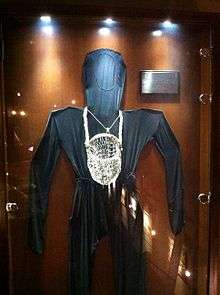
In the early 20th century, Kuwait immensely declined in regional economic importance,[18] mainly due to many trade blockades and the world economic depression.[27] Before Mary Bruins Allison visited Kuwait in 1934, Kuwait lost its prominence in long distance trade.[18] During World War I, the British Empire imposed a trade blockade against Kuwait because Kuwait's ruler (Salim Al-Mubarak Al-Sabah) supported the Ottoman Empire, who was in the Central Powers.[27][28][29] The British economic blockade heavily damaged Kuwait's economy.[29]
The Great Depression negatively impacted Kuwait's economy starting in the late 1920s.[30] International trading was one of Kuwait's main sources of income before oil.[30] Kuwaiti merchants were mostly intermediary merchants.[30] As a result of European decline of demand for goods from India and Africa, the economy of Kuwait suffered. The decline in international trade resulted in an increase in gold smuggling by Kuwaiti ships to India.[30] Some Kuwaiti merchant families became rich due to gold smuggling to India.[31]
Kuwait's pearling industry also collapsed as a result of the worldwide economic depression.[31] At its height, Kuwait's pearling industry led the world's luxury market, regularly sending out between 750 and 800 ship vessels to meet the European elite's need for luxuries pearls.[31] During the economic depression, luxuries like pearls were in little demand.[31] The Japanese invention of cultured pearls also contributed to the collapse of Kuwait's pearling industry.[31]
Following the Kuwait–Najd War of 1919-1920, Ibn Saud imposed a tight trade blockade against Kuwait from the years 1923 until 1937.[27][30] The goal of the Saudi economic and military attacks on Kuwait was to annex as much of Kuwait's territory as possible.[27] At the Uqair conference in 1922, the boundaries of Kuwait and Najd were set.[27] Kuwait had no representative at the Uqair conference.[27] Ibn Saud persuaded Sir Percy Cox to give him two-thirds of Kuwait's territory.[27] More than half of Kuwait was lost due to Uqair.[27] After the Uqair conference, Kuwait was still subjected to a Saudi economic blockade and intermittent Saudi raiding.[27]
In 1937, Freya Stark wrote about the extent of poverty in Kuwait at the time:[30]
Poverty has settled in Kuwait more heavily since my last visit five years ago, both by sea, where the pearl trade continues to decline, and by land, where the blockade established by Saudi Arabia now harms the merchants.
Some prominent merchant families left Kuwait in the early 1930s due to the prevalence of economic hardship. At the time of the discovery of oil in 1937, most of Kuwait's inhabitants were impoverished.
Mubarak the Great
Mubarak's seizure of the throne via murder left his brother's former allies as a threat to his rule, especially as his opponents gained the backing of the Ottomans.[32] In July, Mubarak invited the British to deploy gunboats along the Kuwaiti coast. Britain saw Mubarak's desire for an alliance as an opportunity to counteract German influence in the region and so agreed.[32] This led to what is known as the First Kuwaiti Crisis, in which the Ottomans demanded that the British stop interfering within what they believed to be was their sphere of influence. In the end, the Ottoman Empire backed down, rather than go to war.
In January 1899, Mubarak signed an agreement with the British which pledged that Kuwait would never cede any territory nor receive agents or representatives of any foreign power without the British Government's consent. In essence, this policy gave Britain control of Kuwait's foreign policy.[32] The treaty also gave Britain responsibility for Kuwait's national security. In return, Britain agreed to grant an annual subsidy of 15,000 Indian rupees (£1,500) to the ruling family. In 1911, Mubarak raised taxes. Therefore, three wealthy business men Ibrahim Al-Mudhaf, Helal Al-Mutairi, and Shamlan Ali bin Saif Al-Roumi (brother of Hussain Ali bin Saif Al-Roumi), led a protest against Mubarak by making Bahrain their main trade point, which negatively affected the Kuwaiti economy. However, Mubarak went to Bahrain and apologised for raising taxes and the three business men returned to Kuwait. In 1915, Mubarak the Great died and was succeeded by his son Jaber II Al-Sabah, who reigned for just over one year until his death in early 1917. His brother Sheikh Salim Al-Mubarak Al-Sabah succeeded him.
Anglo-Ottoman convention
.jpg)
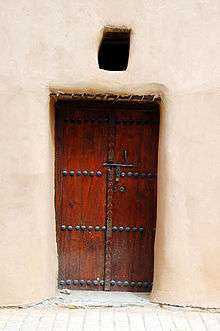
Despite the Kuwaiti government's desire to either be independent or under British protection, in the Anglo-Ottoman Convention of 1913, the British concurred with the Ottoman Empire in defining Kuwait as an autonomous caza of the Ottoman Empire and that the Shaikhs of Kuwait were independent leaders, as well asqaimmaqams (provincial sub-governors) of the Ottoman government. The independence of Kuwait was also highlighted by the statement made by Sheikh Mubarak Al-Sabah to the German team who requested an audience with him over the extension of the Berlin-Baghdad railway to Kuwait in which Mubarak said that he would not sell or rent any piece of his land to a foreigner, and that he did not acknowledge the authority of the Ottomans over Kuwait.[33]
The convention ruled that Shaikh Mubarak had independent authority over an area extending out to a radius of 80 km, from the capital. This region was marked by a red circle and included the islands of Auhah, Bubiyan, Failaka, Kubbar, Mashian and Warba. A green circle designated an area extending out an additional 100 km, in radius, within which the qaimmaqam was authorised to collect tribute and taxes from the natives.
History as a Protected State of Britain
Kuwait–Najd War (1919-1920)
The Kuwait-Najd War erupted in the Aftermath of World War I, when the Ottoman Empire was defeated and the British invalidated the Anglo-Ottoman Convention, declaring Kuwait to be an "independent sheikhdom under British protectorate". The power vacuum, left by the fall of the Ottomans, sharpened the conflict between Kuwait and Najd (Ikhwan). The war resulted in sporadic border clashes throughout 1919-1920. Several hundreds of Kuwaitis died.
The border of the Nejd and Kuwait was finally established by the Uqair Protocol of 1922. Kuwait was not permitted any role in the Uqair agreement, the British and Al Saud decided modern-day Kuwait's borders. Kuwait lost more than 2/3rds of its territory due to Uqair. After the Uqair agreement, relations between Kuwait and Najd remained hostile.
Battle of Jahra
The Battle of Jahra was a battle during the Kuwait-Najd Border War. The battle took place in Al Jahra, west of Kuwait City on October 10, 1920 between Salim Al-Mubarak Al-Sabah ruler of Kuwait and Ikhwan followers of Ibn Saud of Saudi Arabia, king of Saudi Arabia.[34]
A force of 4000 Saudi Ikhwan, led by Faisal Al-Dawish, attacked the Kuwait Red Fort at Al-Jahra, defended by 2000 Kuwaiti men. The Kuwaitis were largely outnumbered by the Ikhwan of Najd.
The Uqair protocol
In response to the various Bedouin raids, the British High Commissioner in Baghdad, Sir Percy Cox, imposed the Uqair Protocol of 1922 which defined the boundaries between Iraq, Kuwait and Nejd. On 1 April 1923, Shaikh Ahmad al-Sabah wrote the British Political Agent in Kuwait, Major John More, "I still do not know what the border between Iraq and Kuwait is, I shall be glad if you will kindly give me this information." More, upon learning that al-Sabah claimed the outer green line of the Anglo-Ottoman Convention (4 April), would relay the information to Sir Percy.
On 19 April, Sir Percy stated that the British government recognised the outer line of the Convention as the border between Iraq and Kuwait. This decision limited Iraq's access to the Persian Gulf at 58 km of mostly marshy and swampy coastline. As this would make it difficult for Iraq to become a naval power (the territory did not include any deepwater harbours), the Iraqi King Faisal I (whom the British installed as a puppet king in Iraq) did not agree to the plan. However, as his country was under British mandate, he had little say in the matter. Iraq and Kuwait would formally ratify the border in August. The border was re-recognised in 1932.
In 1913, Kuwait was recognised as a separate province from Iraq and given autonomy under Ottoman suzerainty in the draft Anglo-Ottoman Convention, however this was not signed before the outbreak of the first World War. The border was revisited by a memorandum sent by the British high commissioner for Iraq in 1923, which became the basis for Kuwait's northern border. In Iraq's 1932 application to the League of Nations it included information about its borders, including its border with Kuwait, where it accepted the boundary established in 1923.[35]
1920s–1940s
Kuwait was recognised as a separate province from Iraq and given autonomy under Ottoman suzerainty in the draft Anglo-Ottoman Convention, however this was not signed before the outbreak of the first World War. The border was revisited by a memorandum sent by the British high commissioner for Iraq in 1923, which became the basis for Kuwait's northern border. In Iraq's 1932 application to the League of Nations it included information about its borders, including its border with Kuwait, where it accepted the boundary established in 1923.[35]
The 1920s and 1930s saw the collapse of the pearl fishery and with it Kuwait's economy. This is attributed to the invention of the artificial cultivation of pearls.
The discovery of oil in Kuwait, in 1938, revolutionised the sheikdom's economy and made it a valuable asset to Britain. In 1941 on the same day as the German invasion of the USSR (22 June) the British took total control over Iraq and Kuwait. (The British and Soviets would invade the neighbouring Iran in September of that year).
See also
References
- Fattah, p. 83
- Ibn Agil, p. 78
- Abu-Hakima, Ahmad Mustafa. "Bani Khalid, Rulers of Eastern Arabia." The Modern History of Kuwait, 1750-1965. London: Luzac, 1983. 2-3. Print
- Gazetteer of the Persian Gulf, Oman, and Central Arabia, Geographical, Volume 1, Historical Part 1, John Gordon Lorimer,1905, p1000
- Abu-Hakima, Ahmad Mustafa. "Arrival of the Utub in Kuwait." The Modern History of Kuwait, 1750-1965. London: Luzac, 1983. 3-5. Print.
- Shadows on the Sand: The Memoirs of Sir Gawain Bell. Gawain Bell. 1983. p. 222.
- ʻAlam-i Nisvāṉ - Volume 2, Issues 1-2. p. 18.
Kuwait became an important trading port for import and export of goods from India, Africa and Arabia.
- Constancy and Change in Contemporary Kuwait City. Mohammad Khalid A. Al-Jassar. 2009. pp. 66–71. ISBN 9781109229349.
- Bennis, Phyllis; Moushabeck, Michel (31 December 1990). Beyond the Storm: A Gulf Crisis Reader. Phyllis Bennis. p. 42. ISBN 9780940793828.
- Hasan, Mohibbul (2007). Waqai-i manazil-i Rum: Tipu Sultan's mission to Constantinople. Mohibbul Hasan. p. 18. ISBN 9788187879565.
- Constancy and Change in Contemporary Kuwait City. Mohammad Khalid A. Al-Jassar. p. 68. ISBN 9781109229349.
- Fattah, Hala Mundhir (1997). The Politics of Regional Trade in Iraq, Arabia, and the Gulf, 1745-1900. Hala Mundhir Fattah. p. 114. ISBN 9780791431139.
- "The Hypothetical Population Pattern of the Population Growth of the State of Kuwait in the pre-oil era". Kuwait University. Retrieved 2013-07-26.
- Miriam Joyce (2006). Kuwait, 1945-1996: An Anglo-American Perspective. p. XV. ISBN 9781135228064.
- Richard Harlakenden Sanger (1970). The Arabian Peninsula. p. 150.
- Kuwait Today: A Welfare State. 1963. p. 89.
- M. Nijhoff (1974). Bijdragen tot de taal-, land- en volkenkunde, Volume 130. p. 111.
- Mary Bruins Allison (1994). Doctor Mary in Arabia: Memoirs. University of Texas Press. p. 1.
- Donaldson, Neil (2008). The Postal Agencies in Eastern Arabia and the Gulf. Neil Donaldson. p. 93. ISBN 9781409209423.
- ́Goston, Ga ́bor A.; Masters, Bruce Alan (2009). Encyclopedia of the Ottoman Empire. p. 321. ISBN 9781438110257.
- Two ethnicities, three generations: Phonological variation and change in Kuwait (PDF) (PhD). Newcastle University. p. 13–14.
- "Kuwait: A Trading City". Eleanor Archer. 2013.
- Fattah, Hala Mundhir (1997). The Politics of Regional Trade in Iraq, Arabia, and the Gulf, 1745-1900. Hala Mundhir Fattah. p. 181. ISBN 9780791431139.
- Potter, L. (2009). The Persian Gulf in History. Lawrence G. Potter. p. 272. ISBN 9780230618459.
- "Lord of Arabia" (PDF). H. C. Armstrong. 1905. pp. 18–19. Archived from the original (PDF) on 2012-05-12.
- Crystal, Jill (1995). Oil and Politics in the Gulf: Rulers and Merchants in Kuwait and Qatar. Jill Crystal. p. 37. ISBN 9780521466356.
- Mary Ann Tétreault (1995). The Kuwait Petroleum Corporation and the Economics of the New World Order. pp. 2–3. ISBN 9780899305103.
- David Lea (2001). A Political Chronology of the Middle East. p. 142. ISBN 9781857431155.
- Lewis R. Scudder (1998). The Arabian Mission's Story: In Search of Abraham's Other Son. p. 104. ISBN 9780802846167.
- Mohammad Khalid A. Al-Jassar (2009). Constancy and Change in Contemporary Kuwait City: The Socio-cultural Dimensions of the Kuwait Courtyard and Diwaniyya. p. 80. ISBN 9781109229349.
- Casey, Michael S.; Thackeray, Frank W.; Findling, John E. (2007). The History of Kuwait. Michael S. Casey. p. 57. ISBN 9781573567473.
- Crystal, Jill. "Kuwait: Ruling Family". Persian Gulf States: A Country Study. Library of Congress. Retrieved 5 March 2011.
- Kumar, India and the Persian Gulf Region, p.157.
- The blood red place of Jahra, Kuwait Times.
- Crystal, Jill. "Kuwait – Persian Gulf War". The Persian Gulf States: A Country Study. Library of Congress. Retrieved 5 March 2011.

